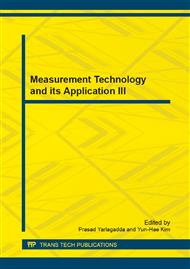[1]
A. Sharp and A. Turner: Concentrations and bioaccessibilities of trace elements in barbecue charcoals. J. Hazard. Mater. Vol. 262 (2013), pp.620-626.
DOI: 10.1016/j.jhazmat.2013.09.020
Google Scholar
[2]
E. Kabir, K.H. Kim, J.W. Ahn, O.F. Hong and J.R. Sohn: Barbecue charcoal combustion as a potential source of aromatic volatile organic compounds and carbonyls. J. Hazard. Mater. Vol. 174 (2010), pp.492-499.
DOI: 10.1016/j.jhazmat.2009.09.079
Google Scholar
[3]
Information on http: /www. tuzvo. sk/files/3_3/katedry_lf/kltm/Servis_studentom/Prilohy_k_predmetom/KVB/KVB-Drevne_uhlie. pdf.
Google Scholar
[4]
M.M. Rahman and K.H. Kim: Release of offensive odorants from the combustion of barbecue charcoals. J. Hazard. Mater. Vol. 215-216 (2012), pp.233-242.
DOI: 10.1016/j.jhazmat.2012.02.055
Google Scholar
[5]
K.H. Kim, S.K. Pandey, E. Kabir, J. Susaya and R.J.C. Brown: The modern paradox of unregulated cooking activities and indoor air quality. J. Hazard. Mater. Vol. 195 (2011), pp.1-10.
DOI: 10.1016/j.jhazmat.2011.08.037
Google Scholar
[6]
S.C. Lee, W.M. Li and L.Y. Chan: Indoor air quality at restaurants with different styles of cooking in metropolitan Hong Kong. Sci. Total Environ. Vol. 279 (2000), pp.181-193.
DOI: 10.1016/s0048-9697(01)00765-3
Google Scholar
[7]
M. Olsson and G. Petersson: Benzene emitted from glowing charcoal. Sci. Total Environ. Vol. 303 (2003), pp.215-220.
DOI: 10.1016/s0048-9697(02)00403-5
Google Scholar
[8]
J. Susaya, K.H. Kim, J.W. Ahn, M.C. Jung and C.H. Kang: BBQ charcoal combustion as an important source of trace metal exposure to humans. J. Hazard. Mater. Vol. 176 (2010), pp.923-937.
DOI: 10.1016/j.jhazmat.2009.11.129
Google Scholar
[9]
J.W. Chen, S.L. Wang, D.P.H. Hsieh, H.H. Yang and H.L. Lee: Carcinogenic potencies of polycyclic aromatic hydrocarbons for back-door neighbors of restaurants with cooking emissions. Sci. Total Environ. Vol. 417-418 (2012), pp.68-75.
DOI: 10.1016/j.scitotenv.2011.12.012
Google Scholar
[10]
J. Ladomerský: Emission analysis and minimization form the wood waste combustion. Wood Res. Vol. 45 (2000), pp.33-44.
Google Scholar
[11]
J. Warnatz, U. Maas and R.W. Dibble: Combustion (Springer, Germany 2006).
Google Scholar
[12]
L. Shi and Y.L. Chew: Experimental study of carbon monoxide for wood under spontaneous ignition condition. Fuel. Vol. 102 (2012), pp.709-715.
DOI: 10.1016/j.fuel.2012.06.053
Google Scholar
[13]
J. Martinka, D. Kačíková, E. Hroncová and J. Ladomerský: Experimental determination of the effect of temperature and oxygen concentration on the production of birch wood main fire emissions. J. Therm. Anal. Calorim. Vol. 110 (2012), pp.193-198.
DOI: 10.1007/s10973-012-2261-2
Google Scholar
[14]
E. Hroncová, J. Ladomerský and C. Adam: The use of wood form degraded land for carbon sequestration. Drew. Vol. 56 (2013), pp.51-61.
Google Scholar
[15]
J. Ladomerský, E. Hroncová and I. Fremal: Perspective techniques of CO2 sequestration. In: 2nd International Conference PETrA 2013 (Pollution and Environment Treatment of Air), Prague, Czech Republic in June 4-6, (2013), 1 p.
Google Scholar
[16]
E. Hroncová, J. Ladomerský: Model for Evaluation of Co-Combustion of Composted Sewage Sludge. 11th International Scientific conference MMA 2012 – Advanced production technologies. Novi Sad, Serbia, (2012), pp.343-345.
Google Scholar
[17]
J. Martinka, T. Chrebet, J. Kráľ and K. Balog: An examination of the behaviour of thermally treated spruce wood under fire conditions. Wood Res. Vol. 58 (2013), pp.599-606.
Google Scholar
[18]
X. Zhang, Q. Chen, R. Bradford, V. Sharif and J. Swithenbank: Experimental investigation and mathematical modelling of wood combustion in a moving grate boiler. Fuel Process. Technol. Vol. 91 (2010), pp.1491-1499.
DOI: 10.1016/j.fuproc.2010.05.026
Google Scholar
[19]
E. Mura, O. Debono, A. Villot and F. Paviet: Pyrolysis of biomass in a semi-industrial scale reactor. Study of the fuel-nitrogen oxidation during combustion of volatiles. Biomass Bioenergy Vol. 59 (2013), pp.187-194.
DOI: 10.1016/j.biombioe.2013.09.001
Google Scholar


